
The bass guitar, electric bass or simply bass, is the lowest-pitched member of the guitar family. It is a plucked string instrument similar in appearance and construction to an electric or acoustic guitar, but with a longer neck and scale length, and typically four to six strings or courses. Since the mid-1950s, the bass guitar has largely replaced the double bass in popular music.

An effects unit or effects pedal is an electronic device that alters the sound of a musical instrument or other audio source through audio signal processing.
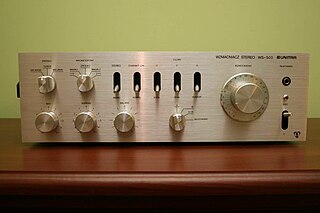
An audio power amplifier is an electronic amplifier that amplifies low-power electronic audio signals, such as the signal from a radio receiver or an electric guitar pickup, to a level that is high enough for driving loudspeakers or headphones. Audio power amplifiers are found in all manner of sound systems including sound reinforcement, public address, home audio systems and musical instrument amplifiers like guitar amplifiers. It is the final electronic stage in a typical audio playback chain before the signal is sent to the loudspeakers.
An audiophile is a person who is enthusiastic about high-fidelity sound reproduction. An audiophile seeks to reproduce the sound of a piece of recorded music or a live musical performance, typically inside closed headphones, In-ear monitors, open headphones in a quiet listening space, or a room with good acoustics.
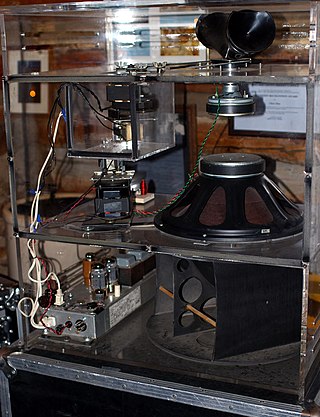
The Leslie speaker is a combined amplifier and loudspeaker that projects the signal from an electric or electronic instrument and modifies the sound by rotating a baffle chamber ("drum") in front of the loudspeakers. A similar effect is provided by a rotating system of horns in front of the treble driver. It is most commonly associated with the Hammond organ, though it was later used for the electric guitar and other instruments. A typical Leslie speaker contains an amplifier, a treble horn and a bass speaker—though specific components depend upon the model. A musician controls the Leslie speaker by either an external switch or pedal that alternates between a slow and fast speed setting, known as "chorale" and "tremolo".

An instrument amplifier is an electronic device that converts the often barely audible or purely electronic signal of a musical instrument into a larger electronic signal to feed to a loudspeaker. An instrument amplifier is used with musical instruments such as an electric guitar, an electric bass, electric organ, synthesizers and drum machine to convert the signal from the pickup or other sound source into an electronic signal that has enough power, due to being routed through a power amplifier, capable of driving one or more loudspeaker that can be heard by the performers and audience.

A guitar amplifier is an electronic device or system that strengthens the electrical signal from a pickup on an electric guitar, bass guitar, or acoustic guitar so that it can produce sound through one or more loudspeakers, which are typically housed in a wooden cabinet. A guitar amplifier may be a standalone wood or metal cabinet that contains only the power amplifier circuits, requiring the use of a separate speaker cabinet–or it may be a "combo" amplifier, which contains both the amplifier and one or more speakers in a wooden cabinet. There is a wide range of sizes and power ratings for guitar amplifiers, from small, lightweight "practice amplifiers" with a single 6-inch speaker and a 10-watt amp to heavy combo amps with four 10-inch or four 12-inch speakers and a 100-watt amplifier, which are loud enough to use in a nightclub or bar performance.

A valve amplifier or tube amplifier is a type of electronic amplifier that uses vacuum tubes to increase the amplitude or power of a signal. Low to medium power valve amplifiers for frequencies below the microwaves were largely replaced by solid state amplifiers in the 1960s and 1970s. Valve amplifiers can be used for applications such as guitar amplifiers, satellite transponders such as DirecTV and GPS, high quality stereo amplifiers, military applications and very high power radio and UHF television transmitters.
Carol Kaye is an American musician. She is one of the most prolific recorded bass guitarists in rock and pop music, playing on an estimated 10,000 recordings in a career spanning over 65 years.

Marshall is a British company that designs and manufactures music amplifiers, speaker cabinets, brands personal headphones and earphones, drums and bongos. The company also owns a record label called Marshall Records. It was founded in London by drum shop owner and drummer, Jim Marshall, and is now based in Bletchley, Milton Keynes, England.

Ampeg is a manufacturer best known for its bass amplifiers. Originally established in 1946 in Linden, New Jersey by Everett Hull and Stanley Michaels as "Michael-Hull Electronic Labs," today Ampeg is part of the Yamaha Guitar Group. Although specializing in the production of bass amplifiers, Ampeg has previously manufactured guitar amplifiers and pickups and instruments including double basses, bass guitars, and electric guitars.
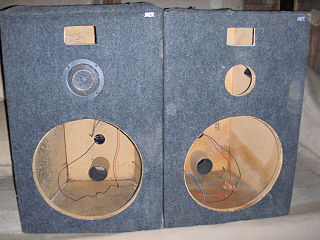
A loudspeaker enclosure or loudspeaker cabinet is an enclosure in which speaker drivers and associated electronic hardware, such as crossover circuits and, in some cases, power amplifiers, are mounted. Enclosures may range in design from simple, homemade DIY rectangular particleboard boxes to very complex, expensive computer-designed hi-fi cabinets that incorporate composite materials, internal baffles, horns, bass reflex ports and acoustic insulation. Loudspeaker enclosures range in size from small "bookshelf" speaker cabinets with 4-inch (10 cm) woofers and small tweeters designed for listening to music with a hi-fi system in a private home to huge, heavy subwoofer enclosures with multiple 18-inch (46 cm) or even 21-inch (53 cm) speakers in huge enclosures which are designed for use in stadium concert sound reinforcement systems for rock music concerts.

A bass amplifier is a musical instrument electronic device that uses electrical power to make lower-pitched instruments such as the bass guitar or double bass loud enough to be heard by the performers and audience. Bass amps typically consist of a preamplifier, tone controls, a power amplifier and one or more loudspeakers ("drivers") in a cabinet.

Distortion and overdrive are forms of audio signal processing used to alter the sound of amplified electric musical instruments, usually by increasing their gain, producing a "fuzzy", "growling", or "gritty" tone. Distortion is most commonly used with the electric guitar, but may also be used with other electric instruments such as electric bass, electric piano, synthesizer and Hammond organ. Guitarists playing electric blues originally obtained an overdriven sound by turning up their vacuum tube-powered guitar amplifiers to high volumes, which caused the signal to distort. While overdriven tube amps are still used to obtain overdrive, especially in genres like blues and rockabilly, a number of other ways to produce distortion have been developed since the 1960s, such as distortion effect pedals. The growling tone of a distorted electric guitar is a key part of many genres, including blues and many rock music genres, notably hard rock, punk rock, hardcore punk, acid rock, and heavy metal music, while the use of distorted bass has been essential in a genre of hip hop music and alternative hip hop known as "SoundCloud rap".

A guitar speaker is a loudspeaker – specifically the driver (transducer) part – designed for use in a combination guitar amplifier of an electric guitar, or for use in a guitar speaker cabinet. Typically these drivers produce only the frequency range relevant to electric guitars, which is similar to a regular woofer type driver, which is approximately 75 Hz — 5 kHz, or for electric bass speakers, down to 41 Hz for regular four-string basses or down to about 30 Hz for five-string instruments.

The Fender Twin and Twin Reverb are guitar amplifiers made by Fender Musical Instruments Corporation. The Twin was introduced in 1952, two years before Fender began selling Stratocaster electric guitars. The amps are known for their characteristically clean tone.

The Fender Bassman is a series of bass amplifiers introduced by Fender during 1952. Initially intended to amplify bass guitars, musicians used the 5B6 Bassman to amplify other instruments, including electric guitars, harmonicas, and pedal steel guitars. Besides being a popular and important amplifier in its own right, the Bassman also became the foundation on which Marshall and other companies built their high-gain tube amplifiers.
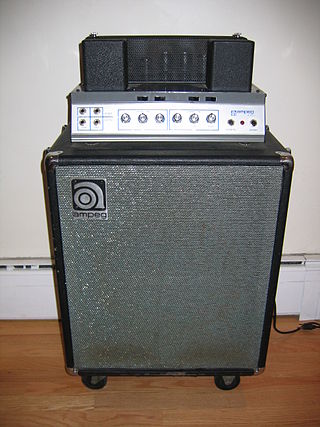
The Portaflex is a line of amplifiers for electric guitars and bass guitars created by Ampeg and originally designed by Jess Oliver. Portaflex referred to the amps’ portable reflex baffle system. The innovative ‘flip-top’ amplifier head design helped dissipate heat and reduce chassis and tube vibration during use, and inverted to store inside the cabinet for portability. The speaker cabinets were carefully tuned with ports and baffling. The introduction of the Portaflex series established a new standard for bass amplification and completely replaced Ampeg’s previous amplifier lineup. The Portaflex line has many different configurations.
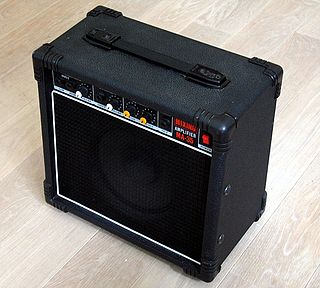
A keyboard amplifier is a powered electronic amplifier and loudspeaker in a wooden speaker cabinet used for amplification of electronic keyboard instruments. Keyboard amplifiers are distinct from other types of amplification systems such as guitar amplifiers due to the particular challenges associated with making keyboards sound louder on stage; namely, to provide solid low-frequency sound reproduction for the deep basslines which keyboards can play and crisp high-frequency sound for the high-register notes. Another difference between keyboard amplifiers and guitar/bass amplifiers is that keyboard amps are usually designed with a relatively flat frequency response and low distortion. In contrast, many guitar and bass amp designers purposely make their amplifiers modify the frequency response, typically to "roll off" very high frequencies, and most rock and blues guitar amps, and since the 1980s and 1990s, even many bass amps are designed to add distortion or overdrive to the instrument tone.

Electric music technology refers to musical instruments and recording devices that use electrical circuits, which are often combined with mechanical technologies. Examples of electric musical instruments include the electro-mechanical electric piano, the electric guitar, the electro-mechanical Hammond organ and the electric bass. All of these electric instruments do not produce a sound that is audible by the performer or audience in a performance setting unless they are connected to instrument amplifiers and loudspeaker cabinets, which made them sound loud enough for performers and the audience to hear. Amplifiers and loudspeakers are separate from the instrument in the case of the electric guitar, electric bass and some electric organs and most electric pianos. Some electric organs and electric pianos include the amplifier and speaker cabinet within the main housing for the instrument.


















